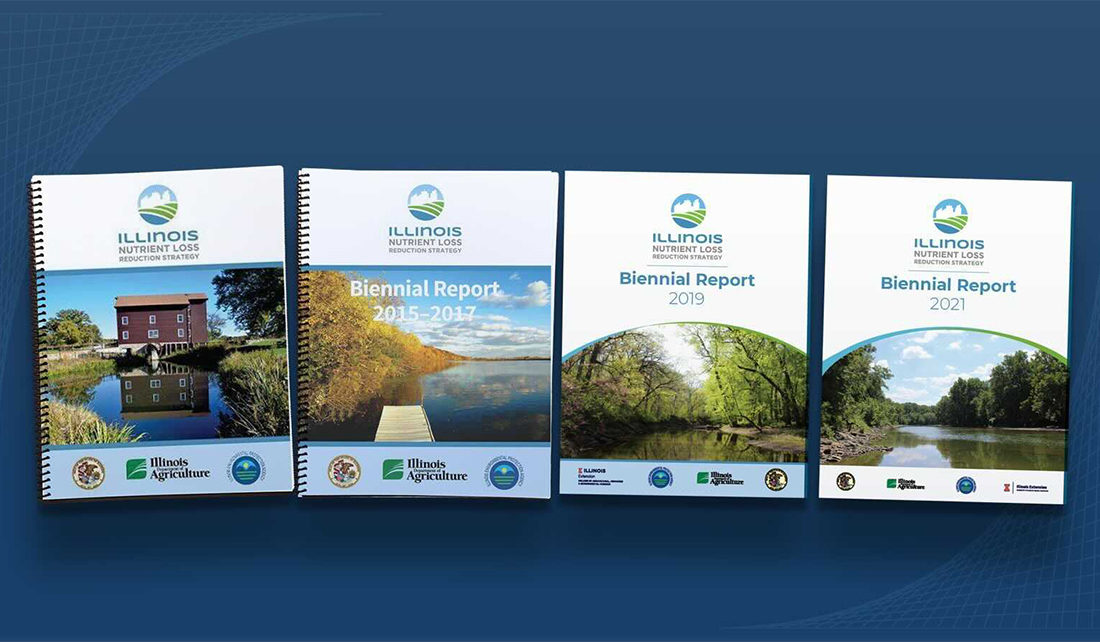
SPRINGFIELD, IL – The Directors of the Illinois Department of Agriculture and Illinois Environmental Protection Agency (EPA) are announcing the release of Illinois’ third Nutrient Loss Reduction Strategy (NLRS) Biennial Report. The Report describes the continued progress being made in Illinois as well as challenges to reduce nutrient losses from multiple sources to improve water quality in Illinois and downstream to reduce the hypoxic zone in the Gulf of Mexico.
The 2015 Illinois NLRS established a goal to reduce the amount of nitrogen and phosphorus in Illinois waterways by 45%, with interim reduction goals of 15% nitrate-nitrogen and 25% total phosphorus by 2025. Implementation of the statewide Strategy is guided by the Illinois EPA, Illinois Department of Agriculture, and University of Illinois Extension with the Policy Working Group and other stakeholder groups and councils. Like other states, Illinois faced unprecedented challenges, including extreme flooding in 2019, followed by the global pandemic in 2020. Despite these events, partner organizations, working both collaboratively and independently, remained committed to the Strategy with the assistance of virtual meetings and continued engagement.
“The report highlights the progress we are making in programs like our cover crop incentive program, Fall Covers for Spring Savings,” said Jerry Costello II, Department of Agriculture Director. “This program is creating awareness and encouraging Illinois’ farmers to look at methods that will reduce nutrient loss.”
“The 2021 Biennial Report highlights accomplishments and new efforts from each sector, which were noteworthy given the increase in precipitation events experienced in Illinois and other states within the Mississippi River basin,” said Illinois EPA Director John Kim. “Work continues by all partners to incorporate additional recommended practices to achieve needed nutrient reductions. We remain committed to the goals established in the 2015 Strategy and look forward to continuing our efforts alongside all stakeholders as we address these challenges.”
It has been evident that additional resources, outreach, and land and facility improvements are necessary to meet the Strategy’s main object of improved water quality in Illinois. Illinois has seen progress in application of agricultural conservation practices, wastewater treatment plant improvements, and government support at the local/watershed level. That said, shifting climate conditions require the need for continued reductions from all sectors.
During 2019-2020, the agriculture sector reported spending nearly $27 million implementing the Strategy outside of traditional government cost-share programs. In addition, the Nutrient Research and Education Council invested $6.9 million for nutrient research and education programs. During that same period, over 72,000 people attended more than 1,020 outreach events including field days, conferences, or workshops to learn about practices that can be implemented to reduce nutrient loss from farm fields.
Through its Partners for Conservation cost-share program, the Illinois Department of Agriculture assisted farmers by redirecting funds to implement an additional 93,750 acres of cover crops after a historic flooding in 2019. The Department’s Fall Covers for Spring Savings program also supported 50,000 additional acres of cover crops in 2019. This year’s report shows Illinois farmers are reporting increased knowledge of the Strategy, which resulted in an increase in cover crops, with 1.4 million acres planted, representing a 135% increase from 2011. Illinois also saw a significant decrease in phosphorus fertilizer application rates in 2019 with 11.2 million acres of croplands reported as having less applied compared to 2011.
Spending by the point source sector increased significantly from $65.1 million in 2019 to $185.2 million in 2020. Point source sector reductions are largely regulated through Illinois EPA’s National Pollutant Discharge Elimination System permit program, with 36% of major municipal wastewater treatment facilities having permit limits for total phosphorus. Facilities are taking additional steps, and since 2018 have developed 71 nutrient reduction optimization studies and 59 nutrient reduction feasibility studies. Outreach and education have also continued in the point source sector with 13 events held, reaching more than 2,600 stakeholders.
Illinois EPA’s Water Pollution Control Loan Program continues to provide low-interest loans for wastewater treatment plant upgrades. In 2019 and 2020, Illinois EPA invested over $200.2 million to projects to improve nutrient removal, green infrastructure, urban stormwater treatment, and control of combined and sanitary sewer overflows.
Thanks to online platforms, the urban stormwater sector continued to reach a broad audience of more than 14,000 stakeholders, sharing tips for homeowners to reduce nutrient loses from their property. Additional practices from this sector showed more than 77% of Illinois’ Municipal Separate Storm Sewer system communities have implemented street sweeping and approximately 64% have implemented leaf collecting. With leaves representing a significant source of urban phosphorus loads, implementation of both practices results in decreased loading. In 2020, Illinois EPA launched the Green Infrastructure Grant Opportunity program, providing funding to projects that reduce stormwater reaching Illinois waterways. Illinois EPA saw great interest in the first year of the program and provided $5 million in funding, with an additional $4 million being provided by local match, which will support 11 projects.
It is well documented that increased precipitation results in higher nutrient loads. Higher nutrient loads are expected to occur in wetter years compared to drier years. Illinois EPA continues to partner with the United States Geological Survey to monitor and analyze water quality data and will continue to discuss options to analyze the data to account for variations in flow. Ultimately, the 2015 Strategy was built to incorporate flexibility into implementation, thus allowing the addition of two new practices – saturated buffers and terraces – to the list of recommended agriculture conservation practices. Additional recommendations may be added in future Biennial Reports.
The Full 2021 Biennial Report is available at: https://www2.illinois.gov/epa/topics/water-quality/watershed-management/excess-nutrients/Pages/nutrient-loss-reduction-strategy.aspx. The next Biennial Report will be published in 2023. The agencies and organizations leading this effort will continue to collaborate and invest in programs that meet the goals of the Illinois NLRS.
Illinois-Indiana Sea Grant is a part of University of Illinois Extension and Purdue Extension.
Contact: Kim Biggs, Illinois EPA (217)558-1536; Krista Lisser, IDOA (217)558-1546

